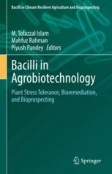Search
Search Results
-
Stability is essential for insecticidal activity of Vip3Aa toxin against Spodoptera exigua
Vegetative insecticidal proteins 3A (Vip3A) were important insecticidal proteins for control of lepidopteran pests. Previous study demonstrated that...

-
Cloning, characterization and evaluation of toxicity of newly identified Vip3Aa proteins from Bacillus thuringiensis recovered from diverse environments for biological control of Helicoverpa armigera
Ten full-length vip3 -type genes amplified from the Bacillus thuringiensis ( Bt ) isolates recovered from various Indian agro-climatic zones and two...

-
Evaluating the effects of Bt protein Vip3Aa on immature Propylea japonica (Thunberg) (Coleoptera: Coccinellidae)
BackgroundGenetically modified (GM) crops have become a common tool for managing insect pests of economic importance. However, before their...

-
Development of a sensitive monoclonal antibody-based sandwich ELISA to detect Vip3Aa in genetically modified crops
ObjectivesTo develop a sensitive monoclonal antibody-based sandwich enzyme-linked immunosorbent assay (ELISA) to detect Vip3Aa in genetically...

-
Enhancing the resilience of transgenic cotton for insect resistance
BackgroundThe efficacy of Bt crystal proteins has been compromised due to their extensive utilization in the field. The second-generation Bt ...

-
The evaluation of resistance risk to Cry2Ab and cross-resistance to other insecticides in Helicoverpa armigera
To delay the resistance of pests to Bt cotton producing Cry1Ac, pyramided cotton has been planted to replace Cry1Ac-cotton. However, the resistance...

-
Insecticidal activity of Bacillus thuringiensis strains isolated from tropical greenhouses towards Cydia pomonella and Spodoptera exigua larvae
Three Bacillus thuringiensis strains were isolated from a specific habitat of tropical greenhouses located in the Botanical Garden of Adam Mickiewicz...

-
Development of broad-spectrum and sustainable resistance in cotton against major insects through the combination of Bt and plant lectin genes
Key messageSecond generation
Bt insecticidal toxin in comibination withAllium sativum leaf agglutinin gene has been successfully expressed in cotton...
-
Isolation and identification of bacteria from the invasive pest Tuta absoluta (Meyrick) (Lepidoptera: Gelechiidae) and evaluation of their biocontrol potential
As an alternative to chemical insecticides, gut bacteria of insects could be used to control insect pests. In this study, bacteria associated with Tuta...

-
Biological control of Spodoptera frugiperda (Nixon) (Lepidoptera: Noctuidae) in new invaded countries using insect pathogens
BackgroundThe fall armyworm (FAW), Spodoptera frugiperda (J.E. Nixon) (Lepidoptera: Noctuidae), is the major insect pest that infests cereal crops...
-
CRISPR/Cas9: a cutting-edge solution for combatting the fall armyworm, Spodoptera frugiperda
The utilization of CRISPR/Cas9 in Spodoptera frugiperda , commonly known as fall armyworm, presents a groundbreaking avenue for pest management. With...

-
Bacillus thuringiensis Proteins: Structure, Mechanism and Biological Control of Insect Pests
Bacillus thuringiensis (Bt) produces a wide variety of insecticidal proteins. It synthesizes δ-endotoxins as parasporal crystalline inclusion bodies...
-
Management of Noctuid Pests Using Genetic Tools
Noctuid moth pests are the most serious pests of crops. Many noctuids are invasive, spreading to different parts of the world. Insecticides are...
-
Evaluation of the Toxicity of Supernatant Cultures and Spore–Crystal Mixtures of Bacillus thuringiensis Strains Isolated from Algeria
Bacillus thuringiensis ( Bt ) is the most used technology for biological control of insect pathogens worldwide. In order to select new Bt candidates...

-
Insect cell culture vis-à-vis insect pest control
BackgroundInsect pests are a major cause for losses in agricultural systems, and it is reported that they alone cause up to 45% loss in annual food...

-
Climate Change Poses Threat to Helicoverpa zea Boddie (Lepidoptera: Noctuidae)
Increasing global temperature causes both biotic and abiotic stresses on living organisms. Changing climates have an effect on the existence of pests...
-
Distribution and Genetic Diversity of Genes from Brazilian Bacillus thuringiensis Strains Toxic to Agricultural Insect Pests Revealed by Real-Time PCR
Bacillus thuringiensis is a Gram-positive aerobic bacterium and the most used biopesticide worldwide. Given the importance of B. thuringiensis strain...

-
Identification and analysis of toxins in novel Bacillus thuringiensis strain Bt S3076-1 against Spodoptera frugiperda and Helicoverpa armigera (Lep.: Noctuidae)
Despite the successful application of toxins from Bacillus thuringiensis as biological control agents against pests, pests are showing resistance...

-
Transgenic maize inbred lines expressing high levels of Bacillus thuringiensis vegetative insecticidal protein (Vip3Aa86) offer effective control of maize stem borer (Chilo partellus)
The increasing incidence of field-evolved resistance in Lepidoptera (bollworms) insects towards Bt δ-endotoxins necessitates the need for an...

-
Host Plant Resistance to Insects in Cotton
Across the globe, cotton production is limited by endemic and introduced insect pests. The incorporation of host plant resistance (HPR), defined as...
